March 15, 2017

By Liz Juchems
So you’re thinking about talking with your tenant or landlord about adding cover crops. With all the great resources available online and in print, where do you begin? That’s where a new publication series by the Iowa Learning Farms can help.
What are cover crops? A cover crop is seeded with the purpose of protecting and improving soil health. Cover crops are normally planted without intent to directly harvest, and are usually grown outside of the regular cash crop growing season. Cover crops work to protect your land’s productivity today and into the future.
What are the benefits to using cover crops? The benefits can be grouped into two categories: short term and long term. The short-term benefits include reduced soil erosion, nutrient recycling, and for livestock producers, forage-grazing potential. Long-term benefits include improved water quality and soil health, as well as increased water infiltration and soil organic matter.
Speaking of yield, will the cover crops impact cash crop yield? In 2008, the Iowa Cover Crop Working Group established an on-farm cereal rye cover crop study. After eight years in the study, the farmer-partners have reported mostly no effect on corn and soybean yields.
What costs are associated with cover crops? Cover crop expenses range from $30 to $50 an acre depending on species and seeding method. Start with small grains, like winter cereal rye and oats, which are less expensive and are easier to establish.
What is the economic value of cover crops? In no-tillage systems, a cereal rye cover crop can reduce soil erosion by 30% to 80%. The reduced soil erosion can be conservatively valued at approximately $6.06 per ton. By targeting cover crops to fields or areas prone to erosion, you can achieve a greater return on your investment.
Who should pay for the practice? Consider sharing the expenses through lease negotiations. Examples of modifications of leases to include cover crops:
• Lower the cash rent rate by the full or partial cost of implementing cover crops.
• Split expenses of seed, application or termination if using a cost-share agreement.
• Extend the length of the lease (e.g., five years), and show commitment to the partnership.
How are cover crops seeded? The two most common methods in Iowa are aerial overseeding and drilling. Aerial seeding into standing corn or soybeans shifts the labor demand to a less busy time of year, but it is the more expensive of the two, due to the need for higher seeding rates and application costs. Drilling requires additional time and passes through the field during the harvest season, but results in more uniform coverage and establishment.
What do I need to know about spring management? If using a species that winterkills, there are no additional time requirements in the spring. When using an overwintering cover crop, spring termination is required to meet crop insurance compliance rules. This can be done with herbicide, rolling-crimping, or tillage. The most common method of termination is herbicide, which is recommended 10 to 14 days before planting.
With the additional residue from the cover crop, will the planter be able to get the seed in the ground? Most planters can handle higher amounts of residue from cover crops with minimal modifications. It is important that planter settings are checked periodically, and necessary adjustments are made to ensure good seed-to-soil contact for germination.
Final advice for those getting started? It is important to recognize that it takes time to learn new management techniques. Consider using the practice on a smaller portion of the land and increasing its use each year. Work together to gather information about the practice, and address concerns early for a smoother transition to the new practice. Your local NRCS staff and ISU Extension field specialists are available to meet with you and your tenants to help answer questions, and to provide resources and technical assistance.
The four-part “Talking With Your Tenant” publication series, along with other print and video resources, are at iowalearningfarms.org/conservation. Copies are available at field days and workshops, or mailed upon request.
Juchems is ILF events coordinator.
You May Also Like




